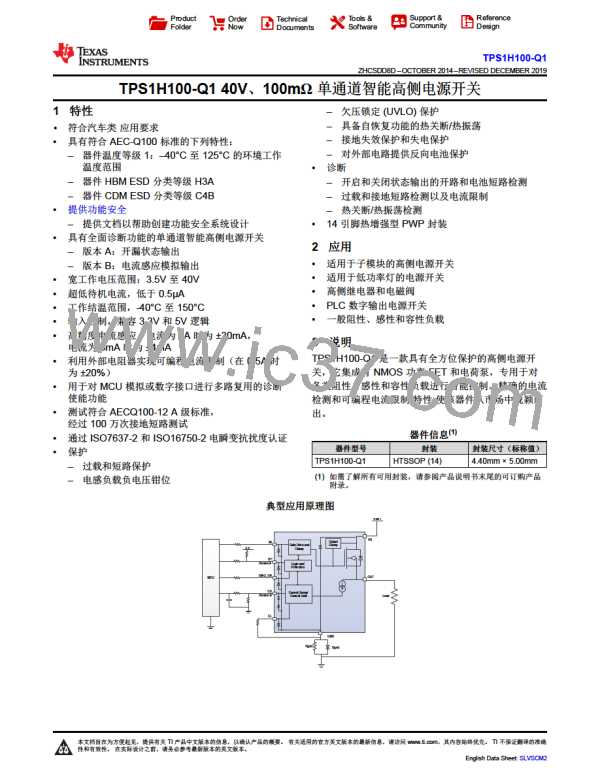TPS1H100-Q1
www.ti.com.cn
ZHCSDD8D –OCTOBER 2014–REVISED DECEMBER 2019
7.3.4.3 Short-to-Battery Detection
Short-to-battery detectioin has the same detection mechanism and behavior as open-load detection, both in the
on-state and off-state. See the fault truth table, Table 1, for more details. In the on-state, the reverse current
flows through the FET instead of the body diode, leading to less power dissipation. Thus, the worst case for off-
state is when reverse current occurs. In the off-state, if VOUT – VVS < VF, short to battery can be detected. (VF is
the body diode forward voltage and typically 0.7 V.) However, the reverse current does not occur. If VOUT – VVS
>
VF, short to battery can be detected, and the reverse current should be lower than Irev2 to ensure the survival of
the device. TI recommends switching on the input for lower power dissipation or the reverse block circuitry for the
supply. See Reverse Current Protection for more external protection circuitry information.
7.3.4.4 Reverse-Polarity Detection
Reverse-polarity detection has the same detection mechanism and behavior as open-load detection, both in the
on-state and off-state. See the fault truth table, Table 1, for more details. In the on-state, the reverse current
flows through the FET instead of the body diode, leading to less power dissipation. Thus, the worst case off-state
is when reverse current occurs. In off-state, the reverse current should be lower than Irev1 to ensure the survival
of the device. See Reverse Current Protection for more external protection circuitry information.
7.3.4.5 Thermal Protection Behavior
Both the absolute temperature thermal shutdown and the dynamic temperature thermal swing diagnostic and
protection are built into the device to increase the maximum reliability of the power FET. Thermal swing is active
when the temperature of the power FET is increasing sharply, that is ΔT = TDMOS – TLogic > Tsw, then the output is
shut down, and the ST pin goes low, or the CS pin is pulled up to VCS,h. It auto-recovers and clears the fault
signal until ΔT = TDMOS – TLogic < Tsw – Thys. Thermal swing function improves device reliability against repetitive
fast thermal variation, as shown in Figure 37. Multiple thermal swings are triggered before thermal shutdown
happens. Thermal shutdown is active when absolute temperature T > TSD. When active, the output is shut down,
and the ST pin goes low, or the CS pin is pulled up to VCS,h. The output is auto-recovered when T < TSD – Thys
;
the current limit is reduced to Ilim,tsd, or half of the programmable current limit value, to avoid repeated thermal
shutdown. However, the thermal shutdown fault signal and half-current limit value are not cleared until the
junction temperature decreases to less than TSD,rst
.
Copyright © 2014–2019, Texas Instruments Incorporated
23

 TI [ TEXAS INSTRUMENTS ]
TI [ TEXAS INSTRUMENTS ]